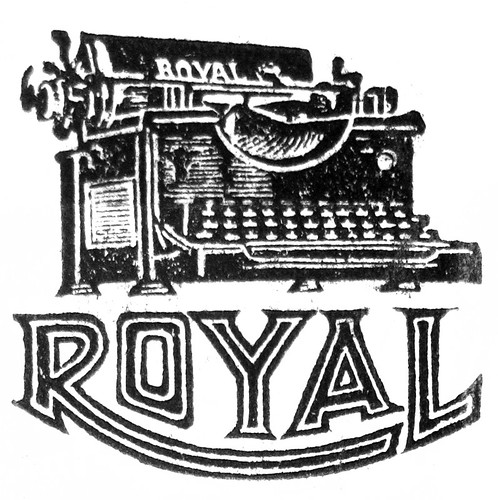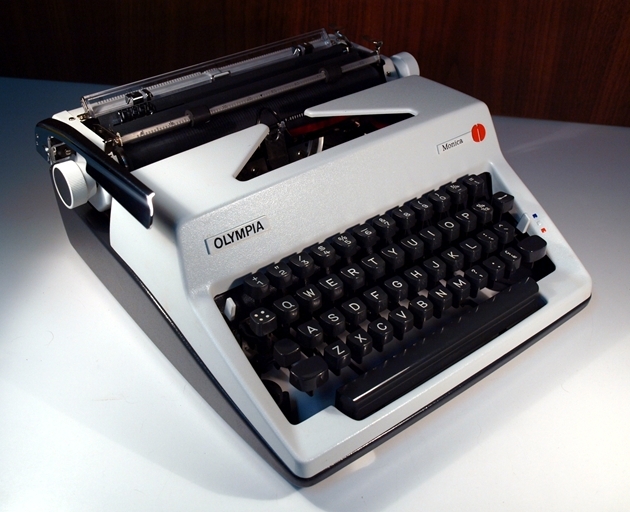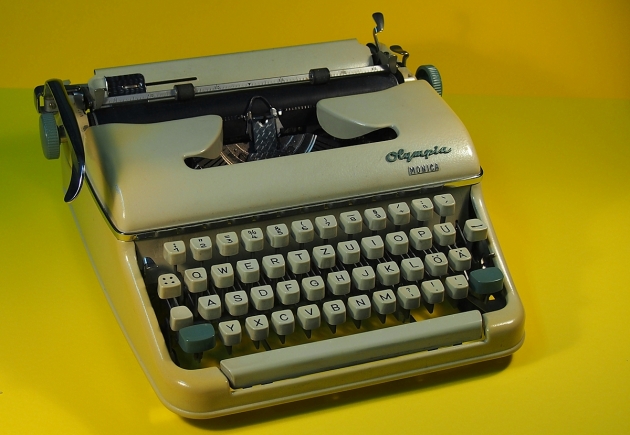- beak
- Key Master
 Offline
Offline 
- From: Qld Australia
- Registered: 24-3-2013
- Posts: 929
Re: Ch-ch-changes in the Olympia SM9
Uwe wrote:
..........in identifying the two variations apart, and the simplest way remains to look at the space bar.
Two? I"m confused;
MOLG mentions four variations and lists a 'deluxe' version. That's five for a start.
Sincerely,
beak.
- TypewriterGuy
- Typewriter Talk Vet
 Offline
Offline 
- From: United States
- Registered: 24-4-2015
- Posts: 1,250
Re: Ch-ch-changes in the Olympia SM9
@Uwe What Im trying to say, is that Olivetti made red cases, but all everyone sees are the blue ones, and rarely a red one. Mostley, there will only be one color of a case.
EDIT Oops, sorry, the valentine case is red. Just ignore this...
Last edited by TypewriterGuy (02-7-2015 12:26:48)
Back from a long break.
Starting fresh with my favorite typer. A Royal Futura!
- Uwe
- Moderator
 Offline
Offline 
- From: Toronto, Canada
- Registered: 12-3-2013
- Posts: 4,410
Re: Ch-ch-changes in the Olympia SM9
beak wrote:
Two? I"m confused; MOLG mentions four variations and lists a 'deluxe' version. That's five for a start.
MOLG states four "versions," but he doesn't define or clarify what he means by the term, nor does he list what those differences actually are. And that tends to be an important thing, because as this discussion is proving, some of us don't consider colour changes to be legitimate criteria when classifying typewriter variations - and some do.
In a previous post I stated three or four variations, because I've never seen written out what exactly the difference between the deluxe and non-deluxe model is. Having carefully examined the SF and SG model ranges, and how Olympia played with names and features, it would be nice to see what the differences are (other than the badging) - if in fact there are any at all.
Incidentally, MOLG is also the same website that on the same page claims the SM3 has a "clever [key] leveling device." It doesn't. The spring system is really a cushioning method to aid in typing comfort, and it's referenced as such in Olympia literature. Still, long ago I gave his claim the benefit of the doubt and carefully measured the deflection angle of an SM3 keytop through its range of motion and found that it does not in fact remain level. Enthusiast and collectors' websites are a great resource of information, but I'd never assume that everything within them to be the gospel truth. I'm not including MOLG is this group, but I've read far too many typewriter blogs that were riddled with inaccurate comments or made claims that were purely based on speculation (or information gleaned from other incorrect blogs).
Back to the subject at hand, it would be great to definitively know how many model variations of the SM9 existed, but maybe we need to start this by carefully defining what a variation is. As I`ve mentioned, I classify a variation as a change in the model`s feature set, or in the design of its physical components. I`ve never counted colour changes because to me a different colour case does nothing to change the typewriter itself.
The pronoun I has always been capitalized in the English language for more than 700 years.
- Retro-Z
- Platen Punisher
 Offline
Offline 
- From: Central Kansas
- Registered: 25-5-2015
- Posts: 62
Re: Ch-ch-changes in the Olympia SM9
I think looking at "variations" as relating only to the feature-set to be a bit simplistic. In many of the other "collecting" fields I have delved into, variations are commonly as simple as a name change, a tiny additonal marking, different labels, slightly different parts/componenets, etc. In the vintage Nikon collecting world, there is an entire variant of Nikon F SLRs that is identified by a tiny little red "dot" by the serial number. Another variant is the first few that were fitted with cloth shutter curtains instead of the common titanium curtains. This shutter curtain difference can play a HUGE difference to collectors, with cloth curtain varieties selling for thousands of dollars, and the titanium versions generally selling for a few hundred at most. I'm betting that many typewriters have a LOT of different, minor changes over their production run (for instance, look at all of the different versions of the Smith-Corona Sterling!).
No, different colors are not a variation if they are an integral part of a certain generation of the machine's development. The white/green/gray SM9 that I posted would be from the early generation of the SM9. If the machine was offered in different colors but was otherwise identical, it would still be considered as the same early-generation "variant". For instance, a black Nikon F "red dot" camera is still the same variant as a chrome Nikon F "red dot" camera.
I think it's important to consider the badging/paint scheme as variants, as they show how the machines evolved within their production period. Generally, many cosmetic changes are incorporated at the same time, which greatly alters the appearance of the machines. With the Nikon F cameras, they were eventually equipped with more "modern" film advance and self timer levers late in their production cycle, and these are a recognized "variation" of the Nikon F, despite all of the functions being basically the same. Focusing soley on mechanical attributes and feature sets doesn't really provide enough info to clearly establish different variants or illustrate how the product evolved. There can even be variants of variants!!!
It can be very easy to over-analyze "variations". I'd say the early badging and color scheme is one distinct variation. Or, make it a subset of the earlier SM9 setup. Something like:
Type 1 (Clear & Set Keys around Spacebar)
Type 1A: White/Gray Painted Case w/ Middle Olympia Script Badge + White & Green Key Tops
Type 1B: White/Gray Painted Case w/ Middle Olympia Script Badge + Black Key Tops
Type 2 (NO Clear & Set Keys around Spacebar)
Type 2A: White/Gray Painted Case w/ Left Olympia & Right Orange "I" Badges + Black Key Tops
Etc.
That is just an example. Then there are the "Deluxe" versions to add, etc., etc., etc.
As can be seen, the biggest change to the cosmetics closely coincides with the biggest change to the feature set with the elimination of the Clear/Set keys around the spacebar. That's why it's important to note the different generations of the color scheme, as it can provide other info. It's also possible to see how someone might be able to claim 4 different variation of the SM9, as even just the 3 I mention plus the "Deluxe versions" gives you 4 "variations" already.
Of course, listing the "variants" can be an endless process, and often times there will be a disagreement what should be included. I've noticed that with some vintage tech, collectors don't get too concerned about these "variants" since the products received so many tiny little changes over their production life. Guess it just depends on how much you enjoy categorizing all of the differences!
Last edited by Retro-Z (05-7-2015 02:09:15)
When you aren't looking for it... you ALWAYS find it!!!
- beak
- Key Master
 Offline
Offline 
- From: Qld Australia
- Registered: 24-3-2013
- Posts: 929
Re: Ch-ch-changes in the Olympia SM9
I think I agree with almost everything said.
Side issue...
This confidently hosted by web page as an SM9 - and the accompanying manual says SM9 too.
The question is;
If the machine has no sign of remotely operated tabs, is it in fact an SM8? - or do we have another variant on our hands?
Last edited by beak (05-7-2015 05:42:01)
Sincerely,
beak.
- •
- thetypewriterman
- Key Master
 Offline
Offline - From: Leiston, England
- Registered: 29-5-2013
- Posts: 942
Re: Ch-ch-changes in the Olympia SM9
The picture is of an early SM8, circa 1967. The giveaway is that it DOESN'T have a carriage release lever on the left. SM9s always had two. Also, on machines of this era, chromed carriage end covers denoted the more luxurious SM9, and white painted carriage ends denoted the 'basic' SM8. Finally, the SM8 had no keyboard touch control, and the SM9 did. Confusingly, there is also the Olympia Monica from this period, which was an SM8 without the tabulator !
- beak
- Key Master
 Offline
Offline 
- From: Qld Australia
- Registered: 24-3-2013
- Posts: 929
Re: Ch-ch-changes in the Olympia SM9
Good stuff. Thanks.
Sincerely,
beak.
- •
- Uwe
- Moderator
 Offline
Offline 
- From: Toronto, Canada
- Registered: 12-3-2013
- Posts: 4,410
Re: Ch-ch-changes in the Olympia SM9
thetypewriterman wrote:
Confusingly, there is also the Olympia Monica from this period, which was an SM8 without the tabulator !
The 4th generation SM version of the Monica:
And the 2nd generation SM version:
I'm quite certain there wasn't a Monica model produced of the 1st and 3rd generation SM.
The pronoun I has always been capitalized in the English language for more than 700 years.
- Fleetwing
- Typewriter Talk Vet
 Offline
Offline - From: Hartford, CT USA
- Registered: 30-6-2015
- Posts: 1,022
Re: Ch-ch-changes in the Olympia SM9
Retro-Z wrote:
I think looking at "variations" as relating only to the feature-set to be a bit simplistic. In many of the other "collecting" fields I have delved into, variations are commonly as simple as a name change, a tiny additonal marking, different labels, slightly different parts/componenets, etc. In the vintage Nikon collecting world, there is an entire variant of Nikon F SLRs that is identified by a tiny little red "dot" by the serial number. Another variant is the first few that were fitted with cloth shutter curtains instead of the common titanium curtains. This shutter curtain difference can play a HUGE difference to collectors, with cloth curtain varieties selling for thousands of dollars, and the titanium versions generally selling for a few hundred at most. I'm betting that many typewriters have a LOT of different, minor changes over their production run (for instance, look at all of the different versions of the Smith-Corona Sterling!).
No, different colors are not a variation if they are an integral part of a certain generation of the machine's development. The white/green/gray SM9 that I posted would be from the early generation of the SM9. If the machine was offered in different colors but was otherwise identical, it would still be considered as the same early-generation "variant". For instance, a black Nikon F "red dot" camera is still the same variant as a chrome Nikon F "red dot" camera.
I think it's important to consider the badging/paint scheme as variants, as they show how the machines evolved within their production period. Generally, many cosmetic changes are incorporated at the same time, which greatly alters the appearance of the machines. With the Nikon F cameras, they were eventually equipped with more "modern" film advance and self timer levers late in their production cycle, and these are a recognized "variation" of the Nikon F, despite all of the functions being basically the same. Focusing soley on mechanical attributes and feature sets doesn't really provide enough info to clearly establish different variants or illustrate how the product evolved. There can even be variants of variants!!!
It can be very easy to over-analyze "variations". I'd say the early badging and color scheme is one distinct variation. Or, make it a subset of the earlier SM9 setup. Something like:
Type 1 (Clear & Set Keys around Spacebar)
Type 1A: White/Gray Painted Case w/ Middle Olympia Script Badge + White & Green Key Tops
Type 1B: White/Gray Painted Case w/ Middle Olympia Script Badge + Black Key Tops
Type 2 (NO Clear & Set Keys around Spacebar)
Type 2A: White/Gray Painted Case w/ Left Olympia & Right Orange "I" Badges + Black Key Tops
Etc.
That is just an example. Then there are the "Deluxe" versions to add, etc., etc., etc.
As can be seen, the biggest change to the cosmetics closely coincides with the biggest change to the feature set with the elimination of the Clear/Set keys around the spacebar. That's why it's important to note the different generations of the color scheme, as it can provide other info. It's also possible to see how someone might be able to claim 4 different variation of the SM9, as even just the 3 I mention plus the "Deluxe versions" gives you 4 "variations" already.
Of course, listing the "variants" can be an endless process, and often times there will be a disagreement what should be included. I've noticed that with some vintage tech, collectors don't get too concerned about these "variants" since the products received so many tiny little changes over their production life. Guess it just depends on how much you enjoy categorizing all of the differences!
I agree with this 100%. Even if the actual product features do not change, a redesign of the cosmetics of the typewriter reflects a significant production change by the manufacturer, and should accordingly be considered a new variant. Even if, for example, the manufacturer changed nothing mechanically or cosmetically, but changed the ribbon cover to plastic, that's a change to the product that was done for a reason -- and also a change that would have signficance for a collector.
I am new to typewriters, but have a lot of experience with cameras. The Nikon F variations are numerous, particularly for the first years of production, and the changes are in many cases are entirely cosmetic, as Retro-Z notes. But these are very important for collectors. Cameras of course are a whole different world from typewriters as far as collecting goes (and I don't see that changing, but I could be wrong) -- they were a lot more expensive than typewriters when new, and generally not made in such high volume. But I see no reason why all the differences in a typewriter's production history -- both functional and cosmetic -- shouldn't be categorized. Whether some variants are ultimately worth more than others remains to be seen, but it's important at least for purposes of proper identification.
- Fleetwing
- Typewriter Talk Vet
 Offline
Offline - From: Hartford, CT USA
- Registered: 30-6-2015
- Posts: 1,022
Re: Ch-ch-changes in the Olympia SM9
thetypewriterman wrote:
The picture is of an early SM8, circa 1967. The giveaway is that it DOESN'T have a carriage release lever on the left. SM9s always had two. Also, on machines of this era, chromed carriage end covers denoted the more luxurious SM9, and white painted carriage ends denoted the 'basic' SM8. Finally, the SM8 had no keyboard touch control, and the SM9 did. Confusingly, there is also the Olympia Monica from this period, which was an SM8 without the tabulator !
Having just gotten an SM9 myself, one of the first version (as shown in post #3 above), I wanted to comment on the statement quoted here that SM9s always had two carriage release levers. Not true on mine, and not true on the one depicted in post #3 -- both have only the one, on the right side. So it looks like that might be another differentiator among versions of the SM9, besides the location of the tab controls -- but necessarily a differentiator from the Monica model. If some of the early versions of the SM9 in fact have two carriage release levers, then that's another variant to note.


